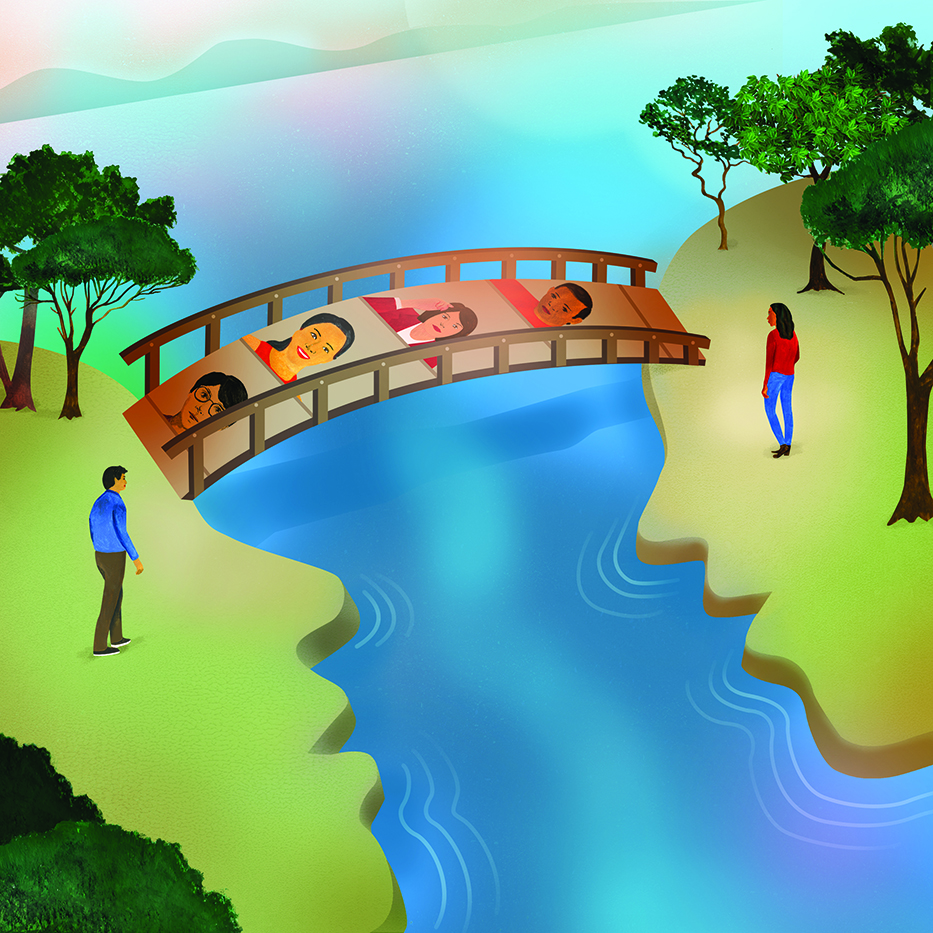A therapist and a patient, meeting together in a quiet, peacefully lit room — that’s likely a common image that comes to mind when picturing the environment in which mental health care takes place. Maybe so; maybe before.
Pre-pandemic, therapists generally did meet their clients in the physical world. Then, millions of the people involved switched whole cloth to a telehealth model, i.e., remote video chat sessions.

“Therapy traditionally has been in person,” says Debra Linesch, interim chair of the Department of Marital and Family Therapy with Specialized Training in Art Therapy, in the LMU College of Communication and Fine Arts. “It’s been very much believed that [an important] part of it is being in the room with someone and hearing their experience, and holding the emotional content of their experience, and being witness to and supportive.”
Linesch says it’s difficult to know with 100% certainty why therapy works. “There are many theories about that,” she says. “But there’s always a sense of alleviating a kind of general existential loneliness that people live with, especially when they’re in pain.”
That pain has skyrocketed since the onslaught of COVID-19. As a consequence, there is a “huge mental health crisis,” Linesch says. Even back in 2019, approximately one-fifth of American adults, or 51.5 million, had a mental illness, and 23 million of them received mental health care services, according to the National Institute of Mental Health.
Almost all of those visits were in person. Then came the pivot. McKinsey & Co. reports that nationwide throughout the health care sector, there were 38 times as many telehealth appointments in July 2021 compared with before the pandemic. That number reached as high as 78 times greater during April 2020.
As a consequence of COVID-19, there is a “huge mental health crisis,” Linesch says.
The McKinsey study further notes that by February 2021, 50% of all psychiatry visits took place via telehealth, as did 30% of substance use disorder treatment. Those figures were only 8% for oncology, cardiology, dental and general medicine visits.
Closer to home, at LMU, there are 52 graduate students enrolled in the therapy program. Thirty are first-year students, and 22 are in their second and final year, says Kathleen Fogel-Richmond, the department practicum coordinator.
Ivan Lopez ’22 is in the second year of the program. Lopez’s first year was spent like so many students during 2020 — online. Now, Lopez is back, in person, although some members of his cohort are still practicing telehealth.
Lopez says telehealth brings challenges. For example, not everyone has access to the internet or WiFi. Not every insurance plan covers telehealth. It can be harder to read body language across the web. “There was definitely the question of, how do we adapt?” Lopez says. “How do we continue to bring service to the people who need it?”
Based on Lopez’s studies and experiences so far, deciding which option is better is difficult. The answer will vary depending on who you’re asking, regardless of age or experience in the field, Lopez says. “There is the relational aspect of creating a physical space of safety for someone. It’s also possible to do that virtually — it looks different, but it can still be facilitated. Really, it just comes down to someone’s personal preference and comfort.” Adds Lopez: “I am willing to accommodate a person’s needs.”
Each academic year, LMU partners with about 45 organizations, mostly in Los Angeles County, to provide mental health services, Fogel-Richmond says. These mission-driven groups include schools, juvenile halls, HIV/AIDS wellness spaces and community centers. When the COVID-19 pandemic came, updated arrangements had to be made with each of them, and concerns ranged from the logistical and technical to the legal and ethical.
“There was definitely the question of, how do we adapt?” Lopez says. “How do we continue to bring service to the people who need it?”
For some of the university’s community of clients, the switch to online services was advantageous. Jessica Bianchi is an assistant professor as well as the clinical director of the Helen B. Landgarten Art Therapy Clinic. “Our student trainers were able to see more kids, and the kids and their families were more likely to come,” she says. Why? “Because it was just easier. [Previously,] transportation might be an issue, or childcare might be an issue, or a stigma around going to therapy might be an issue,” she says. “But via telehealth in their home, they didn’t have to travel, nobody really had to know what they were doing, and they didn’t have to find somebody to take care of their kids.”
Meanwhile, in Bianchi’s private practice, she has a lot of clients in their 20s and early 30s, some of whom are feeling anxious and depressed. “The thought of getting up and going to a therapy office seems really overwhelming,” she explains. “They’ve told me, ‘If I had to get up and go to your office, I would have cancelled this appointment.’”
Jeremy Rosenberg, a frequent contributor to LMU Magazine, is a Los Angeles-based writer. His “Under Spring, Voices + Art + Los Angeles” received the first California Historical Society Book Award. Rosenberg’s writing has appeared in the Los Angeles Times, at KCET.org and elsewhere. Follow him @LosJeremy.
